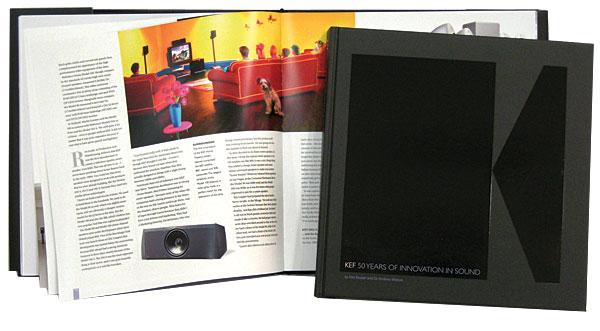| Columns Retired Columns & Blogs |
A treasure and a revelation. This book far exceeded my expectations. Worth every single $ of the asking price.

Ken Kessler's latest "coffee-tabler" (my favorite publishing-industry insider neologism) celebrates the 50th anniversary of the founding of KEF Electronics by documenting the history of the venerable loudspeaker manufacturer. While the book doesn't quite start with a bang, it does start with an evocative vignette. The year was 1979, the place the ballroom of Buckingham Palace. Her Majesty the Queen, about to present KEF's founder, Raymond Cooke, with the medal representing his having been made an Officer of the Most Excellent Order of the British Empire (OBE), inquired, perhaps formulaically, "This is for loudspeakers?"
Cooke replied (the proper verb might be deadpanned), "High-fidelity stereo loudspeakers, Ma'am."
What is important to realize is that it had been only 18 years between this ceremony and KEF's founding, in Kent, in a Nissen hut, Britain's WWI-era ancestor of America's WWII Quonset hut: shabby. From such humble beginnings to Empire-wide and worldwide recognition in 18 years: not shabby. KEF is an acronym for Kent Engineering and Foundry, makers of such agricultural machines as hops pickers, from which Cooke acquired the premises for his new venture.
The book has 20 chapters, hundreds of photographs, four appendices, a list of products, a bibliography, and a thorough index. Production values are on a par with Kessler's books about Quad and McIntosh, although the cover is, I think characteristically for KEF, a bit self-effacing. (Art director Henry Nolan designed all three.) The page layout is outstanding, as is the photography, which provides object lessons in how to make close-ups of woofers and tweeters look dramatic rather than prosaic.
This time around, Kessler is joined by a collaborator, Dr. Andrew Watson. Watson was Head of both Acoustics and Technical Communications at KEF, which gave him insider knowledge of the company's voluminous archives. The book's organization is roughly chronological. However, in the heart of the book, the chapter divisions are by product line, such as "The KEF Reference Series" and "Coda II and Coda 7." The thread that continues throughout KEF: 50 Years of Innovation in Sound comprises interviews with some 30 employees, with the occasional diverting sidebar.
KEF's Reference 105.2 was among the first "super-speakers" I heard, ca 1981. My own loudspeakers at the time were I.M. Fried's Q/2s; my predisposition to admire the 105.2 had been whetted by notices in the audio press (most likely including Audio magazine), and by the cool factor of the speaker's recessed red LEDs, which allowed the user to zero in the tweeter/midrange head modules while leaving the bass modules squared up with the room boundaries.
The 105.2's sound was as much a revelation as had been my encounter a few years before with Chartwell's LS3/5a—which used KEF drivers. Had I known then what I know now, I would have bought the 105.2s once and bought them right. In his Foreword, Kessler states that, between KEF drivers being the heart of the BBC's LS3/5a and various all-KEF-made models, he believes that he has listened to KEF products more than to those from any other company.
It should surprise no one that Raymond Cooke was a music-loving Royal Navy veteran of WWII whose wartime experience added to his earlier technical training. Or that he spent a year as a design engineer at the BBC before, by increments, creating himself a job at Wharfedale, one of the then-reigning British speaker companies. As Cooke later noted, "I had a remarkable, unintended apprenticeship." But a corporate takeover of Wharfedale indicated to Cooke that if he wanted to see his new ideas realized, he'd have to strike out on his own.
Cooke and KEF's achievements are actually rather easy to summarize. Cooke and his coworkers reduced the average size of home loudspeakers with adequate bass from 9–10 cubic feet to about 2 cubic feet (both Cooke and Kessler credit the late Edgar Villchur, of AR, with his parallel invention of the so-called acoustic-suspension woofer). They were the first to begin large-scale production of drivers with cones made of materials other than paper, the first to apply Fast Fourier Transform analysis to the measuring of loudspeakers, and among the first to apply modern quality-control principles to driver manufacture.
Early on, Cooke made the executive decision that the potential benefits of selling raw drivers to competitors outweighed the obvious negative of thus helping those competitors up their own games. In short order, an international Who's Who of speaker makers, from England's IMF (later TDL) and Scotland's Linn to Italy's Sonus Faber and the US's Wilson Audio Specialties, were using KEF drivers. The signal success was the B110 4.5" mid/woofer, which was used in the BBC's LS3/5a minimonitor design. Counting only examples licensed by the BBC, some 50,000 pairs of the LS3/5a were made—100,000 B110s. At its peak, KEF was making a total of 10,000 raw drivers, of all types, per week.
It seems to me that KEF, like many other old-line manufacturers, spent a certain amount of time wandering in the desert—a period I date from just after they made 500 "final" pairs of LS3/5a's in piano gloss black. In time, a series of unfortunate events resulted in KEF's being put into receivership. Luckily, outside investors deemed KEF's heritage worth preserving and building on. GP Acoustics International has revitalized the company with flagship products—the Muon and the Blade, both covered here in loving detail, and the more-affordable Reference series—and with renewed attention to marketing, of which KEF: 50 Years of Innovation in Sound is an example.
KEF's future looks bright, and its past is educational fun to read about. Again, well done, Ken. Highly recommended.

A treasure and a revelation. This book far exceeded my expectations. Worth every single $ of the asking price.